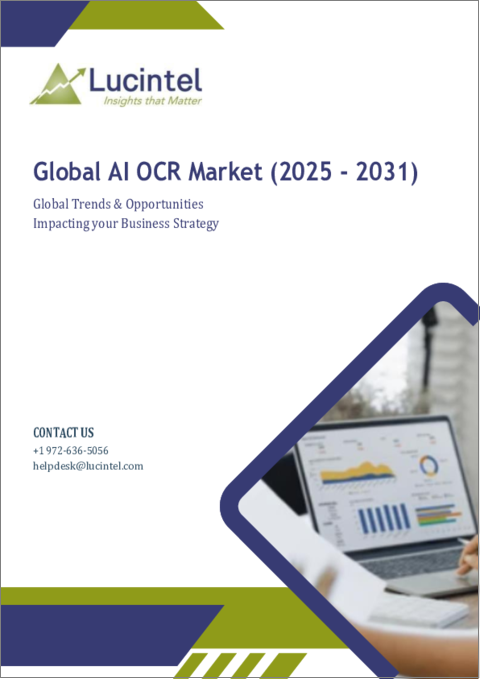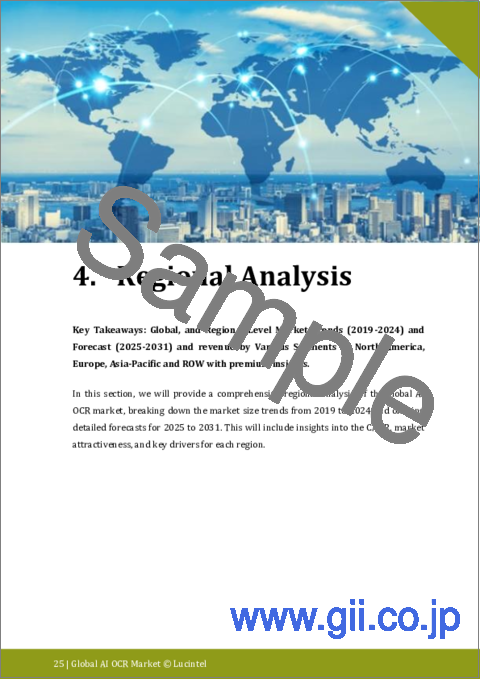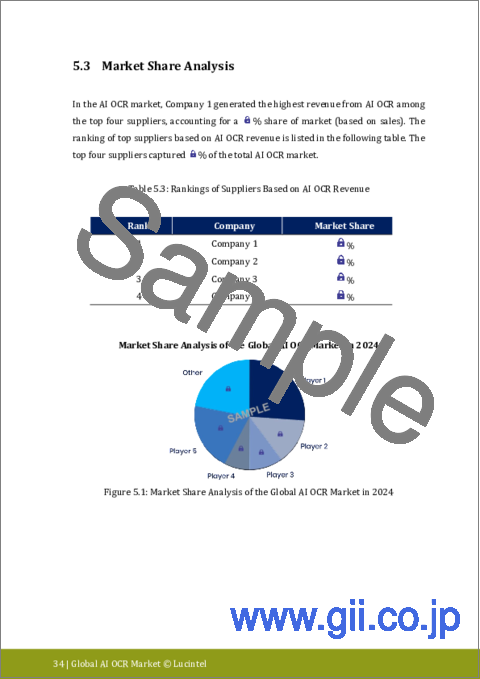|
|
市場調査レポート
商品コード
1597254
AI OCR市場レポート:2030年までの動向、予測、競合分析AI OCR Market Report: Trends, Forecast and Competitive Analysis to 2030 |
||||||
カスタマイズ可能
適宜更新あり
|
|||||||
| AI OCR市場レポート:2030年までの動向、予測、競合分析 |
|
出版日: 2024年10月04日
発行: Lucintel
ページ情報: 英文 150 Pages
納期: 3営業日
|
全表示
- 概要
- 目次
AI OCRの動向と予測
世界のAI OCR市場は、2024年から2030年にかけてCAGR 14.8%で成長すると予測されます。この市場の主な促進要因は、文書のデジタル化とデータ抽出プロセスの自動化に対する需要の増加、効率的な文書管理とコンプライアンスのためのAI搭載の光学式文字認識(OCR)の成長、データの正確性の向上と規制遵守のためのヘルスケアや金融などの分野でのAI OCRの最も高い採用率です。世界のAI OCR市場の将来は、金融、教育、銀行、医療、ロジスティクス市場における機会で有望視されています。
- Lucintelの予測では、タイプ別ではインテリジェント文字認識が予測期間中に最も高い成長を遂げる見込みです。
- 用途別では、金融が最も高い成長が見込まれます。
- 地域別では、APACが予測期間中に最も高い成長が見込まれます。
AI OCR市場の戦略的成長機会
AI OCR市場は、技術的進歩と自動化需要の増加により、様々なアプリケーションにおいてかなりの戦略的成長機会を提示しています。特定された各機会は、市場の潜在力を活用しようとする利害関係者にとって不可欠です。
- 金融サービスの自動化:AI OCRは、金融分野における請求書処理、融資申請、コンプライアンス文書の自動化にますます適用されています。この自動化により、業務が迅速化され、機密性の高い金融情報の取り扱いの精度が向上すると同時に、必要な工数が削減されます。
- ヘルスケア・ドキュメンテーション:ヘルスケアプロバイダーは、AI OCRを使用して患者の治療記録をデジタル化し、請求プロセスを合理化するケースが増えています。このアプリケーションは、重要な情報をすぐに利用できるようにし、事務作業と管理負担を軽減することで、患者中心のアプローチを強化します。
- 法的文書管理:法律事務所はAI OCRソリューションを使用して、文書管理と訴訟準備を強化しています。法律文書からのデータ抽出を自動化することで、効率性と生産性が向上し、重要な情報に簡単にアクセスできるようになります。
- 小売業の在庫管理:小売業界におけるAI OCRテクノロジーは、在庫管理の改善に役立っています。棚卸しや注文処理を自動化することで、これらのソリューションは精度を高め、手作業による在庫管理に費やす時間を削減します。
- 政府および公共部門アプリケーション:政府は、公文書を効率的にデジタル化して管理するためにAI OCRを採用しています。これにより、透明性の向上、ペーパーワークの削減、公共サービスの提供が強化され、この分野の成長が促進されます。
こうした戦略的成長機会は、さまざまな用途にわたるAI OCR市場の大きな可能性を示しています。金融、ヘルスケア、法律、小売、および政府部門に焦点を当てることで、企業はAI OCR技術を活用して効率性を高め、革新的なアプリケーションを開発することができます。
AI OCR市場の促進要因・課題
技術、経済、規制の状況など、いくつかの要因がこの市場を牽引しています。すべての利害関係者は、変化し続ける状況を活用するために、これらの促進要因と課題を理解する必要があります。
AI OCR市場を牽引する要因は以下の通りです:
- 技術の進歩:AI OCR市場の主な成長促進要因は、人工知能と機械学習の進歩です。これらの技術はOCRの速度と精度を向上させ、様々な産業におけるデータ処理に不可欠なものとなっています。
- 自動化への需要の高まり:さまざまな分野における自動化のニーズは、AI OCR技術の主要な推進力となっています。企業は、手作業によるデータ入力を最小限に抑えつつ、効率的な運用の恩恵を受けようとしており、OCRシステムの採用が増加しています。
- 規制コンプライアンス:特にファイナンスとヘルスケアにおける規制要件が、AI OCRテクノロジーの採用を促進しています。組織は、データ保護規制を遵守するために、効率的で安全なデータ管理プロセスを確保する必要があります。
AI OCR市場における課題は以下の通り:
- データ・プライバシーの懸念:データ・プライバシーの懸念:プライバシーの問題がAI OCR技術の採用を妨げる可能性があります。組織は複雑な規制を乗り越えなければならず、導入はより困難なものとなります。
- 統合の複雑さ:AI OCRソリューションを既存のシステムに統合することは、特にレガシーなインフラを持つ組織にとって困難な場合があります。このような複雑さは、コストを増加させ、そのようなソリューションを提供するために必要な時間を延長する可能性があります。
- 言語処理の限界:大幅な進歩にもかかわらず、AI OCRシステムを使用して複数の言語や複雑な文字で書かれた文書を効果的に処理するには課題が残っています。これらの限界に対処することは、より広く採用される上で極めて重要です。
これらの課題と促進要因は相互に関連しており、それぞれがAI OCR市場全体に影響を与えています。イノベーションと成長は、課題分野と活用すべき 促進要因を理解することで体系的に導くことができます。
目次
第1章 エグゼクティブサマリー
第2章 世界のAI OCR市場:市場力学
- イントロダクション、背景、分類
- サプライチェーン
- 業界の促進要因と課題
第3章 2018年から2030年までの市場動向と予測分析
- マクロ経済動向(2018~2023年)と予測(2024~2030年)
- 世界のAI OCR市場の動向(2018-2023)と予測(2024-2030)
- タイプ別:世界のAI OCR市場
- インテリジェントな文字認識
- インテリジェントなテキスト認識
- 光学マーク認識
- 用途別:世界のAI OCR市場
- ファイナンス
- 教育
- 銀行
- 医療
- ロジスティクス
第4章 2018年から2030年までの地域別市場動向と予測分析
- 地域別世界のAI OCR市場
- 北米のAI OCR市場
- 欧州のAI OCR市場
- アジア太平洋のAI OCR市場
- その他地域のAI OCR市場
第5章 競合分析
- 製品ポートフォリオ分析
- 運用統合
- ポーターのファイブフォース分析
第6章 成長機会と戦略分析
- 成長機会分析
- タイプ別の世界のAI OCR市場の成長機会
- 用途別の世界のAI OCR市場の成長機会
- 地域別の世界のAI OCR市場の成長機会
- 世界のAI OCR市場の新たな動向6.3:戦略分析
- 新製品開発
- 世界のAI OCR市場の能力拡大
- 世界のAI OCR市場における合併、買収、合弁事業
- 認証とライセンシング
第7章 主要企業の企業プロファイル
- Rossum
- Aigen
- Automation Hero
- Advance Innovations
- Mint
- Net Smile
- Processmaker
AI OCR Trends and Forecast
The future of the global AI OCR market looks promising with opportunities in the finance, education, bank, medical, and logistic markets. The global AI OCR market is expected to grow with a CAGR of 14.8% from 2024 to 2030. The major drivers for this market are an increase in demand for the digitization of documents and automation of data extraction processes, the growth of AI-powered optical character recognition (OCR) for efficient document management and compliance, and the highest adoption of AI OCR in sectors like healthcare and finance for improved data accuracy and regulatory compliance.
- Lucintel forecasts that, within the type category, intelligent character recognition is expected to witness the highest growth over the forecast period.
- Within the application category, finance is expected to witness the highest growth.
- In terms of regions, APAC is expected to witness the highest growth over the forecast period.
Gain valuable insights for your business decisions with our comprehensive 150+ page report.
Emerging Trends in the AI OCR Market
Various emerging trends in the AI OCR market will continue shaping its future. These trends reflect the growing need for automation, efficiency, and enhanced data processing capabilities across almost all sectors.
- Integration of Machine Learning: The integration of machine learning algorithms further increases the practicality and accuracy of OCR solutions. Through training on data patterns, text recognition becomes possible in various fonts and layouts, significantly improving performance in real-world applications.
- Expansion in Mobile Applications: With the proliferation of mobile devices comes the rise of mobile OCR applications. Users can now capture documents on the go and direct digitization into systems for instant processing and access. This trend has a substantial impact on areas like retail and finance, where rapid data entry is essential.
- Multilingual Support: Due to increasing global business expansion, the demand for multilingual OCR is growing. AI technologies are evolving to support multiple languages and scripts, simplifying document management for organizations in diverse international markets.
- Enhanced Security Features: AI OCR solutions are addressing growing concerns over data privacy and security by implementing enhanced security features. These include encryption and compliance with data protection regulations, ensuring that sensitive information is treated securely while facilitating efficient data processing.
- Cloud-Based OCR Solutions: Cloud computing significantly affects the OCR market. The scalability, easy access, and integration capabilities of cloud-based OCR solutions provide organizations the opportunity to use OCR technology without heavy upfront investments, thereby enhancing operational flexibility.
All these emerging trends are impacting the AI OCR market by adding functionalities, making it more accessible, and improving security. For organizations that recognize the importance of automated processing, these trends will further promote innovation and adoption across sectors.
Recent Developments in the AI OCR Market
Recent trends in the AI OCR market reflect major developments aimed at boosting efficiency and accuracy in data processing.
- Improved Recognition Algorithms: Advances in deep learning and neural networks have led to the development of more sophisticated recognition algorithms. These evolved algorithms are particularly effective for reading handwritten and stylized text, allowing OCR systems to be more versatile across various applications.
- AI-Powered Data Extraction: Businesses are increasingly utilizing AI for data extraction processes. AI-based OCR solutions can intelligently read documents, categorize them, and perform relevant extractions with minimal human interference, thus streamlining workflows and minimizing errors.
- User-Friendly Interfaces: The development of intuitive user interfaces for OCR applications is on the rise. Users, even those with no technical background, can work with OCR technologies using modern interfaces designed for easy interaction.
- Robust APIs for Integration: The emergence of robust APIs has simplified the integration of OCR capabilities into existing software systems. Businesses are evolving their applications by incorporating OCR functionalities, thereby enhancing overall efficiency in data management.
- Sustainability Focus: Greater awareness of environmental sustainability has led to the growth of OCR solutions among companies. Further developments in these technologies promote digital documentation, helping organizations reduce their carbon footprint and enhance overall resource efficiency.
Such developments greatly influence the AI OCR market by enhancing capabilities, improving user experiences, and driving efficiency. With the adoption of these innovations by organizations, significant improvements in data processing workflows are expected.
Strategic Growth Opportunities for AI OCR Market
The AI OCR market presents considerable strategic growth opportunities across various applications due to technological advances and the increasing demand for automation. Each identified opportunity is essential for any stakeholder looking to capitalize on the market potential.
- Financial Services Automation: AI OCR is increasingly applied in automating invoice processing, loan applications, and compliance documentation in the financial sector. This automation reduces manpower requirements while accelerating operations and improving accuracy in handling sensitive financial information.
- Healthcare Documentation: Healthcare providers are increasingly using AI OCR to digitize patient care records and streamline billing processes. This application enhances a patient-centric approach by ensuring the ready availability of critical information and reducing paperwork along with the administrative burden.
- Legal Document Management: Law firms are using AI OCR solutions to enhance document management and case preparation. Automation in extracting data from legal documents increases efficiency and productivity, ensuring that important information is easily accessible.
- Retail Inventory Management: AI OCR technologies in the retail industry help businesses improve inventory management. By automating stock-taking and order processing, these solutions enhance accuracy and reduce the time spent on manual inventory management.
- Government and Public Sector Applications: Governments are adopting AI OCR to efficiently digitize and manage public records. This leads to improved transparency, reduced paperwork, and enhanced public service delivery, thereby boosting growth in this sector.
These strategic growth opportunities represent significant potential in the AI OCR market across different applications. Focusing on the finance, healthcare, legal, retail, and government sectors can help businesses leverage AI OCR technologies for increased efficiency and innovative applications.
AI OCR Market Driver and Challenges
Several factors are driving this market, including technological, economic, and regulatory conditions. All stakeholders must understand these drivers and challenges to capitalize on the ever-changing landscape.
The factors driving the AI OCR market include:
- Technological Advancements: The main growth drivers in the AI OCR market are advances in artificial intelligence and machine learning. These technologies have increased the speed and accuracy of OCR, making them essential for data processing in various industries.
- Growing Demand for Automation: The need for automation across different sectors is a major driver for AI OCR technologies. Businesses are seeking to minimize manual data entry while benefiting from efficient operations, leading to increased adoption of OCR systems.
- Regulatory Compliance: Regulatory requirements, particularly in finance and healthcare, are fostering the adoption of AI OCR technologies. Organizations must ensure efficient and secure data management processes to comply with data protection regulations.
Challenges in the AI OCR market include:
- Data Privacy Concerns: Privacy issues may deter the adoption of AI OCR technologies. Organizations must navigate complex regulations, making implementation more challenging.
- Integration Complexities: Integrating AI OCR solutions into existing systems can be challenging, especially for organizations with legacy infrastructure. These complexities may increase costs and extend the time required to deliver such solutions.
- Limitations in Language Processing: Despite significant advancements, challenges remain in effectively processing documents in multiple languages or complex scripts using AI OCR systems. Addressing these limitations is crucial for wider adoption.
These challenges and drivers are interconnected, each influencing the overall AI OCR market. Innovation and growth can be systematically guided by understanding the areas of challenge and the drivers to leverage.
List of AI OCR Companies
Companies in the market compete on the basis of product quality offered. Major players in this market focus on expanding their manufacturing facilities, R&D investments, infrastructural development, and leverage integration opportunities across the value chain. Through these strategies AI OCR companies cater increasing demand, ensure competitive effectiveness, develop innovative products & technologies, reduce production costs, and expand their customer base. Some of the AI OCR companies profiled in this report include-
- Rossum
- Aigen
- Automation Hero
- Advance Innovations
- Mint
- Net Smile
- Processmaker
AI OCR by Segment
The study includes a forecast for the global AI OCR market by type, application, and region.
AI OCR Market by Type [Analysis by Value from 2018 to 2030]:
- Intelligent Character Recognition
- Intelligent Text Recognition
- Optical Mark Recognition
AI OCR Market by Application [Analysis by Value from 2018 to 2030]:
- Finance
- Educate
- Bank
- Medical
- Logistics
AI OCR Market by Region [Analysis by Value from 2018 to 2030]:
- North America
- Europe
- Asia Pacific
- The Rest of the World
Country Wise Outlook for the AI OCR Market
The growth of the AI OCR market is driven by advancements in machine learning, natural language processing, and the increasing demand for automation across various sectors. The United States, China, Germany, India, and Japan are at the forefront of adopting AI OCR technologies to streamline processes, improve data quality, and enhance user experience. These developments are critical for sectors such as finance, healthcare, and logistics, which require high levels of efficient data management.
- United States: AI OCR technologies in the U.S. are increasingly applied to streamline business processes and automate data entry and document scanning. Significant improvements include machine learning algorithms that enhance text recognition in complex documents. Compliance with data protection regulations is also a key focus, leading to the design of secure and scalable OCR solutions. Investments across industries are increasing to achieve operational efficiency and reduce costs through AI-driven technologies.
- China: The country is rapidly adopting AI OCR technology, particularly within the e-commerce and finance sectors. Companies are leveraging advanced OCR functionalities to automate invoice processing and customer service. Innovation is flourishing as the government continues to promote digital transformation. However, concerns regarding data safety and confidentiality necessitate the establishment of strong regulatory frameworks to ensure the safe utilization of these technologies.
- Germany: Germany's manufacturing and automotive sectors significantly influence the AI OCR market. Businesses are deploying OCR solutions to manage documents and extract data from technical materials. The demand for Industry 4.0 solutions is growing, with firms interested in AI OCR to improve operational efficiency while ensuring compliance with GDPR regarding sensitive data protection.
- India: The Indian AI OCR market is growing rapidly, particularly in the banking and healthcare sectors, where efficient data management is essential. Companies are investing heavily in OCR technologies for document processing automation and improved service delivery. The high penetration of smartphones is also driving demand for mobile-based OCR applications. However, challenges remain in processing regional languages, necessitating further advancements in AI to cater effectively to diverse users.
- Japan: AI OCR solutions are increasingly recognized in sectors such as logistics and retail, where businesses seek to enhance operational efficiency through automated inventory and order management. Innovations in image recognition and natural language processing continue to improve OCR precision. Additionally, rising age-related pressures are driving demand for automation as businesses aim to alleviate workforce shortages. Regulatory considerations surrounding data handling are crucial for developing secure OCR applications that comply with emerging technologies.
Features of the Global AI OCR Market
Market Size Estimates: AI OCR market size estimation in terms of value ($B).
Trend and Forecast Analysis: Market trends (2018 to 2023) and forecast (2024 to 2030) by various segments and regions.
Segmentation Analysis: AI OCR market size by type, application, and region in terms of value ($B).
Regional Analysis: AI OCR market breakdown by North America, Europe, Asia Pacific, and Rest of the World.
Growth Opportunities: Analysis of growth opportunities in different type, application, and regions for the AI OCR market.
Strategic Analysis: This includes M&A, new product development, and competitive landscape of the AI OCR market.
Analysis of competitive intensity of the industry based on Porter's Five Forces model.
If you are looking to expand your business in this or adjacent markets, then contact us. We have done hundreds of strategic consulting projects in market entry, opportunity screening, due diligence, supply chain analysis, M & A, and more.
This report answers following 11 key questions:
- Q.1. What are some of the most promising, high-growth opportunities for the AI OCR market by type (intelligent character recognition, intelligent text recognition, and optical mark recognition), application (finance, educate, bank, medical, and logistics), and region (North America, Europe, Asia Pacific, and the Rest of the World)?
- Q.2. Which segments will grow at a faster pace and why?
- Q.3. Which region will grow at a faster pace and why?
- Q.4. What are the key factors affecting market dynamics? What are the key challenges and business risks in this market?
- Q.5. What are the business risks and competitive threats in this market?
- Q.6. What are the emerging trends in this market and the reasons behind them?
- Q.7. What are some of the changing demands of customers in the market?
- Q.8. What are the new developments in the market? Which companies are leading these developments?
- Q.9. Who are the major players in this market? What strategic initiatives are key players pursuing for business growth?
- Q.10. What are some of the competing products in this market and how big of a threat do they pose for loss of market share by material or product substitution?
- Q.11. What M&A activity has occurred in the last 5 years and what has its impact been on the industry?
- Market Report
Table of Contents
1. Executive Summary
2. Global AI OCR Market : Market Dynamics
- 2.1: Introduction, Background, and Classifications
- 2.2: Supply Chain
- 2.3: Industry Drivers and Challenges
3. Market Trends and Forecast Analysis from 2018 to 2030
- 3.1. Macroeconomic Trends (2018-2023) and Forecast (2024-2030)
- 3.2. Global AI OCR Market Trends (2018-2023) and Forecast (2024-2030)
- 3.3: Global AI OCR Market by Type
- 3.3.1: Intelligent Character Recognition
- 3.3.2: Intelligent Text Recognition
- 3.3.3: Optical Mark Recognition
- 3.4: Global AI OCR Market by Application
- 3.4.1: Finance
- 3.4.2: Educate
- 3.4.3: Bank
- 3.4.4: Medical
- 3.4.5: Logistics
4. Market Trends and Forecast Analysis by Region from 2018 to 2030
- 4.1: Global AI OCR Market by Region
- 4.2: North American AI OCR Market
- 4.2.1: North American AI OCR Market by Type: Intelligent Character Recognition, Intelligent Text Recognition, and Optical Mark Recognition
- 4.2.2: North American AI OCR Market by Application: Finance, Educate, Bank, Medical, and Logistics
- 4.3: European AI OCR Market
- 4.3.1: European AI OCR Market by Type: Intelligent Character Recognition, Intelligent Text Recognition, and Optical Mark Recognition
- 4.3.2: European AI OCR Market by Application: Finance, Educate, Bank, Medical, and Logistics
- 4.4: APAC AI OCR Market
- 4.4.1: APAC AI OCR Market by Type: Intelligent Character Recognition, Intelligent Text Recognition, and Optical Mark Recognition
- 4.4.2: APAC AI OCR Market by Application: Finance, Educate, Bank, Medical, and Logistics
- 4.5: ROW AI OCR Market
- 4.5.1: ROW AI OCR Market by Type: Intelligent Character Recognition, Intelligent Text Recognition, and Optical Mark Recognition
- 4.5.2: ROW AI OCR Market by Application: Finance, Educate, Bank, Medical, and Logistics
5. Competitor Analysis
- 5.1: Product Portfolio Analysis
- 5.2: Operational Integration
- 5.3: Porter's Five Forces Analysis
6. Growth Opportunities and Strategic Analysis
- 6.1: Growth Opportunity Analysis
- 6.1.1: Growth Opportunities for the Global AI OCR Market by Type
- 6.1.2: Growth Opportunities for the Global AI OCR Market by Application
- 6.1.3: Growth Opportunities for the Global AI OCR Market by Region
- 6.2: Emerging Trends in the Global AI OCR Market 6.3: Strategic Analysis
- 6.3.1: New Product Development
- 6.3.2: Capacity Expansion of the Global AI OCR Market
- 6.3.3: Mergers, Acquisitions, and Joint Ventures in the Global AI OCR Market
- 6.3.4: Certification and Licensing
7. Company Profiles of Leading Players
- 7.1: Rossum
- 7.2: Aigen
- 7.3: Automation Hero
- 7.4: Advance Innovations
- 7.5: Mint
- 7.6: Net Smile
- 7.7: Processmaker





